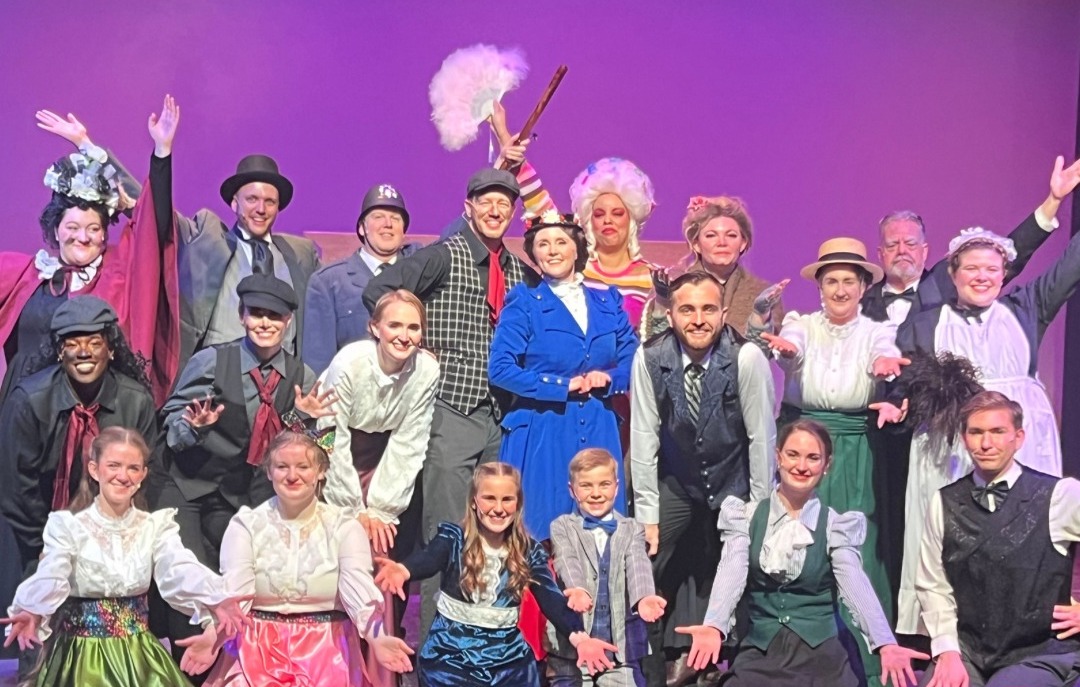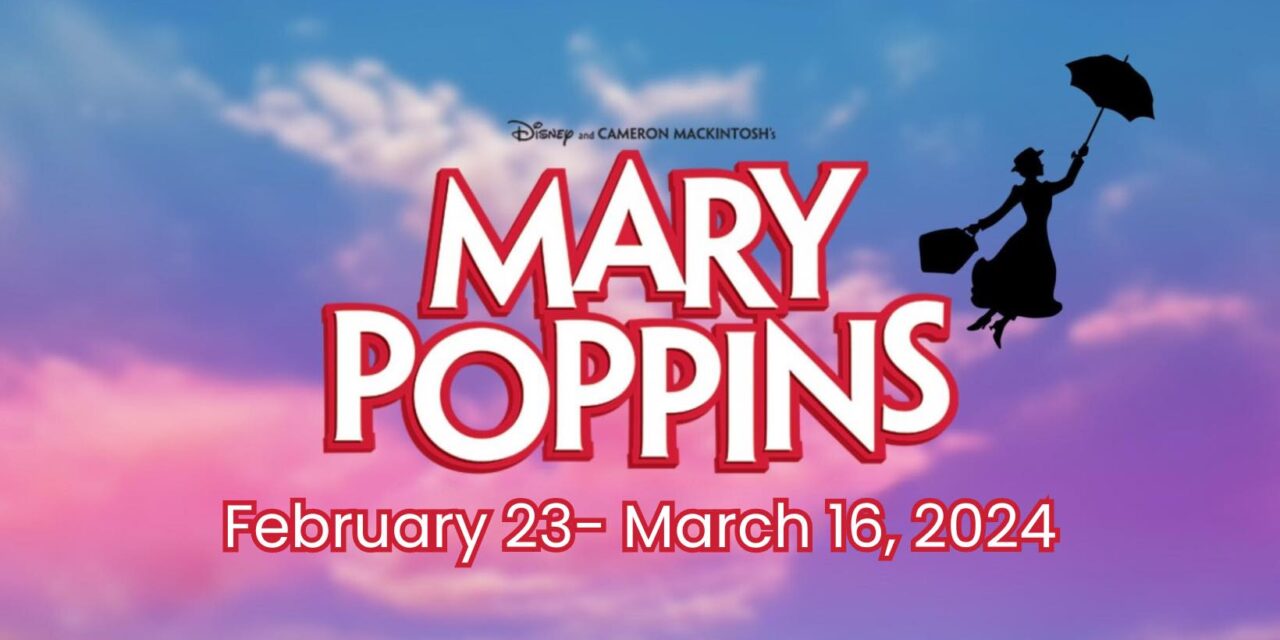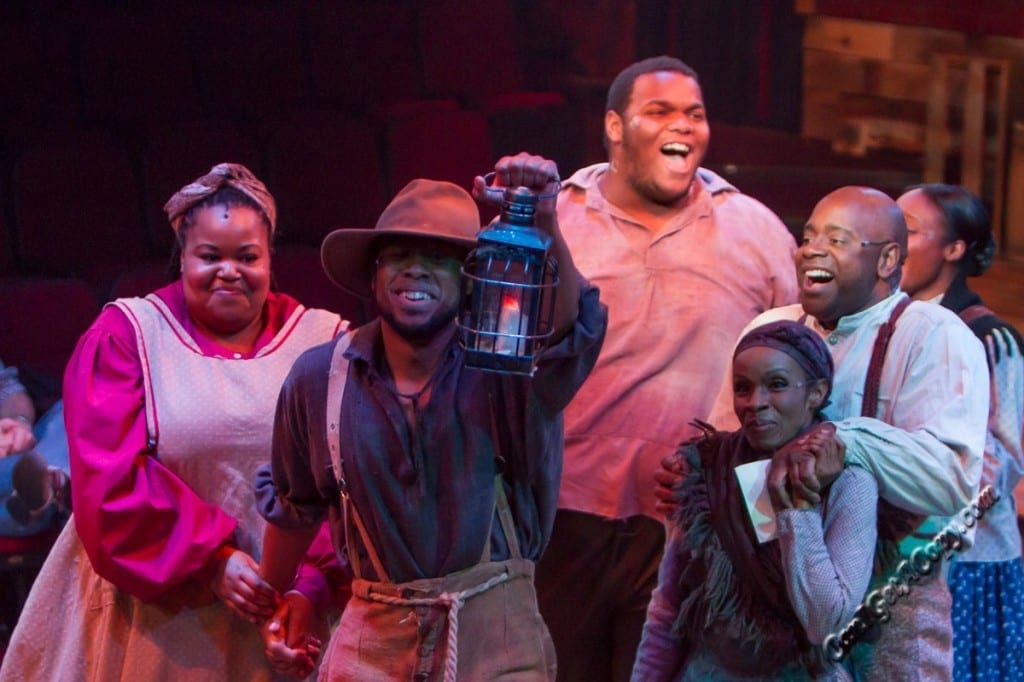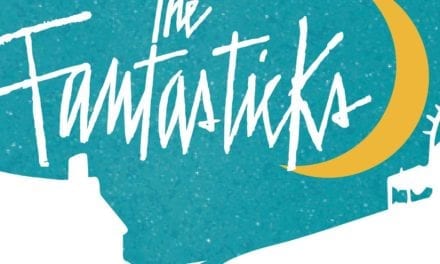OGDEN — The mysterious and magical Mary Poppins is a timeless character. The original story about the English nanny was penned by P.L. Travers and published 90 years ago, with the Disney film now celebrating 60 years. This 2004 stage adaptation uses elements of both the book and film while adding new songs by George Stiles and Anthony Drewe. The musical’s book by Julian Fellowes focuses on relevant social issues of Edwardian England, while still centering on the redemption of George Banks. Given so much source material and hands involved in writing the script, there are places the story feels uneven. Despite this, I found that The Ziegfeld Theater’s production under the direction of Marinda Maxfield does an excellent job of highlighting the fun and sweet Disney moments while keeping the stakes high for the Banks family.
The main challenge to the title role is the inescapable fact that one will be compared to Julie Andrews’ seminal performance in the film. Natalie Peterson takes on the challenging role with poise and precision. With an equal measure of stern and sweet, Peterson gave a superb rendition of Mary from the moment she burst through the Banks’ fireplace with a dazzling smile. Her first number, “Practically Perfect,” displayed a beautiful soprano voice and warmly invited the audience into the nursery with the children. Appropriate to her role, Peterson kept attention fixed on her for the whole show.
Bert (Jeff Erickson) nonchalantly opened the play with a casual charm, and his relationship with Mary felt warm and friendly. As the main representative of the working class, he was upbeat as he led the ensemble in “Jolly Holiday” and “Step In Time.” Erickson has a nice voice and dances well enough, but the most spontaneous moments happened when Bert twerked his way around Mary who would obviously never indulge in such crass gyrations, but she still gave a twinkling smile to show she cared for Bert.

Show closes March 16, 2024.
The main theme of the musical revolves around George Banks, played by Alma Lambson, who succeeded in creating a nice arch for his character. He begins the show as stern and foreboding father who is only interested in establishing order at 17 Cherry Tree Lane, but he “rediscovers humanity” and his love for his family. His wife, Winifred Banks (Riah Shumate), has her own journey of deciding the kind of wife and mother she wants to be and home she wants to run.
Set and projection designer Caleb Parry was the production’s hero. Each scene was set with projections that looked like Edwardian England, but with a watercolor-like swirl that made the scenery feel like the sidewalk art that Burt sketched at the beginning of the show. Skillfully made wagon pieces quickly moved scenes between the parlor, nursery, kitchen, park and London rooftops. Some pieces were used to perform magical feats of breaking and repairing which made some young patrons gasp with delight. Parry’s designs allowed scenes to be set instantly and keep the pace of the show moving quickly. With a hefty run time of two hours and forty-five minutes, these quick scene changes were critical. There were a few sound issues on opening night. For example, the background music was too loud in the first half of the opening number — and there was one incident of microphone feedback — but all technical issues were resolved quickly and didn’t detract for long.
Costume designer Stephanie Colyar’s excellent costuming also set the stage for success. Mary’s classic looks were spot on — from her iconic white dress during the fantastical sequence “Supercalifragilisticexpialidocious” to her various coats and hats, each piece was practically perfect. The show required a huge number of costumes and quick changes which were well designed to keep pace up. A few of the ensemble’s costume pieces were not period accurate, but I didn’t find it too distracting. Sometimes it might have been to accommodate movement and such. Featuring distinct palettes for each venue was a strong choice — for example, the stark colors of the bank costumes contrasted with the psychedelic shades in Mrs. Corry’s magic sweet shop.
A notable character drawn from the book was Miss Andrew (Ginny Teuscher), George Banks’ nanny who is called in to help with the children. Her dark, muddy-colored costume, dead fox about her neck and towering hat made the character instantly recognizable as the opposite of Mary with her bright red coat, bird umbrella and restrained straw hat. While Mary Poppins wants to fix the family and bring them together, Miss Andrew embodies why they were broken and wants to tear them further apart. Miss Andrew and Mary Poppins’ duet “Brimstone and Treacle” was one of my favorite numbers of the evening. Both vocals astounded as they circled each other in an operatic nanny showdown that made my jaw drop.
Being part of the Disney musical family, this show was conceived as a big Broadway musical with huge budgets for special effects, sets and costumes. Scaling the show to fit so seamlessly into the Ziegfeld’s venue was a feat of design and direction in itself. The ensemble had to play everything from statues to chimney sweeps, servants, town people and living toys while singing and dancing in multiple styles. While some of the dancing was a little weak and distracting at times, the whole cast nailed the intricate hand dance number “Let’s Go Fly a Kite” while spelling one of the longest words in the English language.
This production expertly highlighted classic Disney moments while making thoughtful social commentary through the story of George Banks and his family. It is the epitome of a “spoonful of sugar,” and I recommend it to patrons of all ages for a practically perfect family night at the theater.





